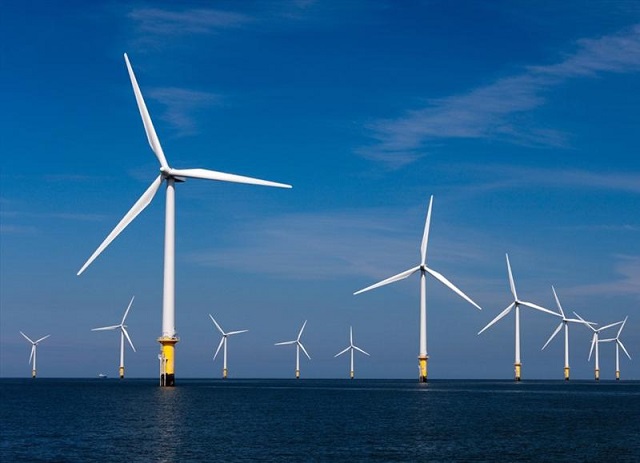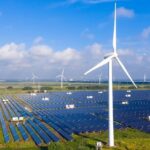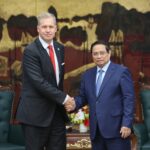Significant Capacity Increases
By 2030, the total capacity of LNG power is expected to reach 22,524 MW, domestic gas-fired power to reach 14,930 MW, coal-fired power to reach 31,055 MW, hydropower to range between 33,294 and 34,667 MW, solar power to range from 46,459 to 73,416 MW, and onshore wind power to be between 26,066 and 38,029 MW.
Offshore wind power, catering to domestic demands, aims for a capacity of 6,000 MW by 2030 and an increase to 17,032 MW by 2035.
With regards to the two Ninh Thuan nuclear power plants, each is expected to have a capacity of 2,000 – 3,200 MW and be operational between 2030 and 2035.
Biomass, waste, and excess heat from industrial processes are also encouraged, with a total biomass power capacity of 1,523 – 2,699 MW, and power generated from waste and solid waste ranging from 1,441 to 2,137 MW.
By 2030, the total capacity of energy storage batteries is projected to reach approximately 10,000 – 16,300 MW. The development of concentrated solar power must be coupled with the installation of energy storage batteries, with a minimum ratio of 10% capacity and storage of 2 hours.
Boosting Electricity Import and Export, and Promoting Green Energy
As per the plan, Vietnam will increase electricity imports from countries with high hydropower potential. By 2030, the total import capacity from Laos is expected to reach approximately 9,360 – 12,100 MW, based on bilateral cooperation agreements between the two governments. Additionally, there are plans to utilize the potential for imports from China, in alignment with connection conditions, at a reasonable scale.
If favorable conditions and reasonable prices are met, there is an option to increase the maximum scale or advance the timeline for importing electricity from Laos to the northern region.

QHĐ8 adjustments showcase a push for renewable energy, especially wind power.
|
Conversely, electricity export is identified as a new spearhead in regional economic cooperation. By 2030, Vietnam aims to increase its electricity export capacity to Cambodia to approximately 400 MW.
By 2035, the export capacity to potential markets such as Singapore, Malaysia, and other regional partners could reach 5,000 – 10,000 MW, with a minimum scale of 10,000 MW maintained until 2050. This export level can be adjusted higher depending on the actual demands of the importing parties, ensuring economic efficiency, national energy security, and national defense.
To facilitate electricity exports and the production of new energy, the Ministry of Industry and Trade has identified the Central and Southern regions as potential areas, with an export capacity of 5,000 – 10,000 MW.
Renewable energy will be utilized to produce new types of energy (such as green hydrogen and green ammonia) to serve domestic needs and exports. Priority will be given to areas with good renewable energy potential and favorable electricity grid infrastructure, with a development scale aiming for 15,000 MW, mainly from offshore wind power.
Formation of Renewable Energy Industrial Centers
The Ministry of Industry and Trade also proposes the construction of two inter-regional renewable energy industrial and service centers.
The northern center will be located in Hai Phong, Quang Ninh, and Thai Binh, with the potential for future expansion to neighboring areas. This center will include factories that manufacture equipment for wind and solar power, logistics services, and specialized ports to support the construction, operation, and maintenance of renewable energy projects.
Additionally, there will be low-carbon emission industrial parks and research and training facilities for specialized human resources in the field of clean energy.
Similarly, the southern center is planned to be located in Ninh Thuan, Binh Thuan, Ba Ria-Vung Tau, and Ho Chi Minh City, which have superior potential for wind and solar power and port infrastructure.
The development model here is similar to that of the northern center, aiming to build a complete value chain for the renewable energy industry in the South.
Assigning Tasks to Key Units
The organization and implementation are specifically assigned to each ministry, locality, and key enterprise in the energy sector.
The Ministry of Finance will coordinate with the Ministry of Industry and Trade to develop electricity pricing policies in line with market mechanisms and financial incentives to support the implementation of the planning.
Ministries and sectors will proactively propose policies and resolve bottlenecks. People’s Committees of provinces and cities will update planning, allocate land, clear sites, and monitor the progress of power projects.
Specialized units under the Ministry of Industry and Trade will regularly inspect and supervise the implementation of power source and grid projects, propose solutions for projects that are behind schedule, closely monitor the fuel supply situation, especially gas and coal for power generation, and promote the construction of LNG receiving infrastructure. They will also focus on electricity-saving propaganda and prepare a draft amendment to the Law on Energy Conservation and Efficient Use.
In the business block, the Vietnam Electricity Group (EVN) plays a key role in ensuring safe and stable power supply. EVN is responsible for implementing the assigned power source and transmission grid projects, reviewing the balance of electricity supply and demand across the system, and coordinating with localities to remove obstacles in site clearance, grid connection, labor productivity improvement, cost savings, and management innovation to reduce electricity prices. The Group must take responsibility if projects fall behind schedule, affecting power supply security.
The Vietnam National Oil and Gas Group (PetroVietnam, PVN) will focus on exploring and exploiting new gas fields such as Lot B, Blue Whale, and Ken Bau, as well as building infrastructure, ports, and gas systems to serve LNG imports. At the same time, it will play a key role in implementing offshore wind power projects when conditions permit.
The Vietnam Coal and Mineral Industries Group (TKV) and Dong Bac Corporation are responsible for ensuring coal supply for power generation. In addition to enhancing domestic production capacity, they will implement power projects as assigned.
Hai Au
– 15:58 02/06/2025
“US LNG Giant Aims to Make Vietnam a Regional Distribution Hub”
On May 29, at the Government Headquarters, the Prime Minister met with Steven Kobos, Chairman and CEO of Excelerate Energy (US), and his colleagues who were visiting and working in Vietnam.
Unveiling the Revised Power Development Master Plan
The dynamic development of domestic power sources is pivotal, and the Amended Power Development Plan 8 provides a clear strategic direction for electricity import and export within the ASEAN region and the Greater Mekong Subregion.





















